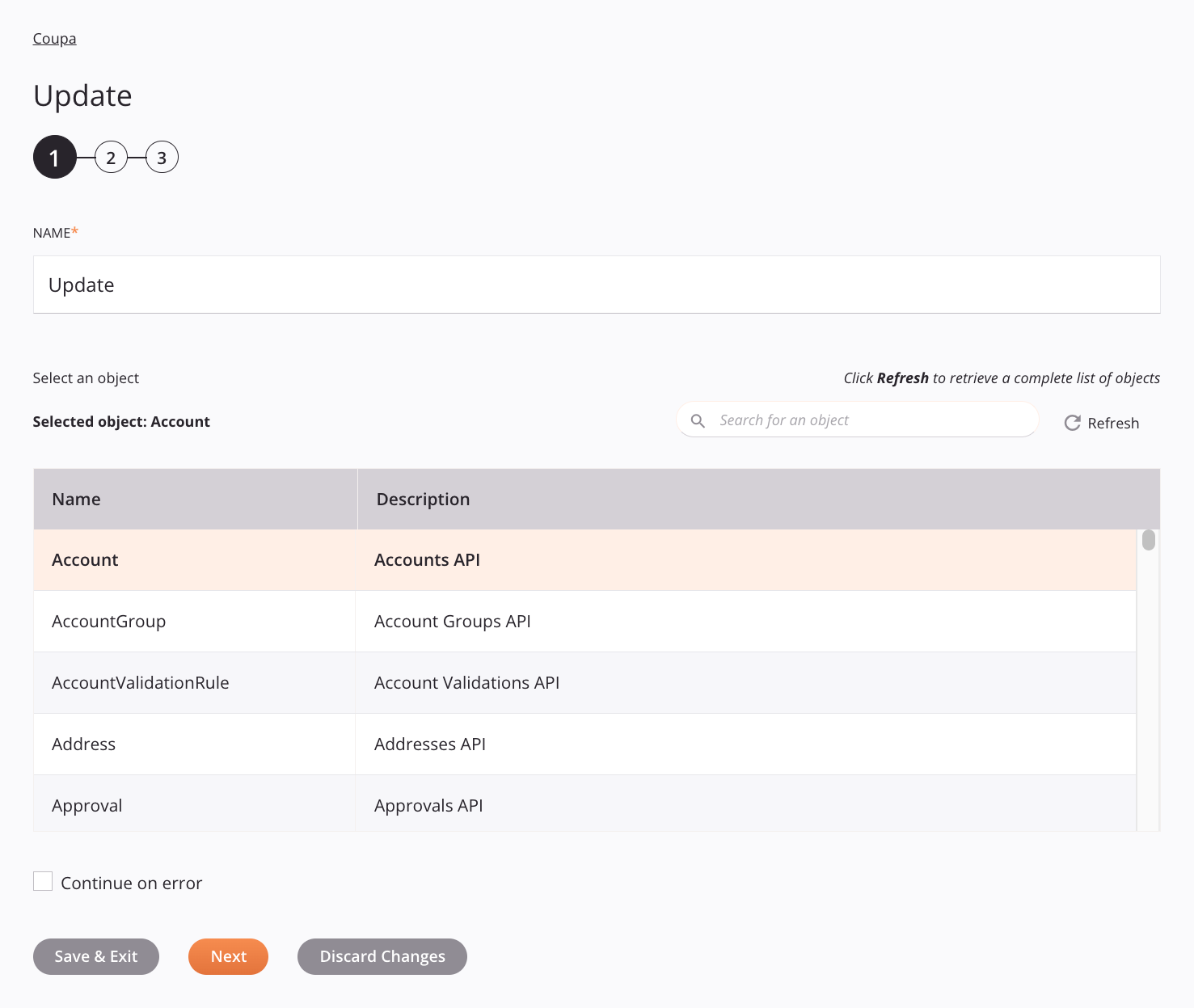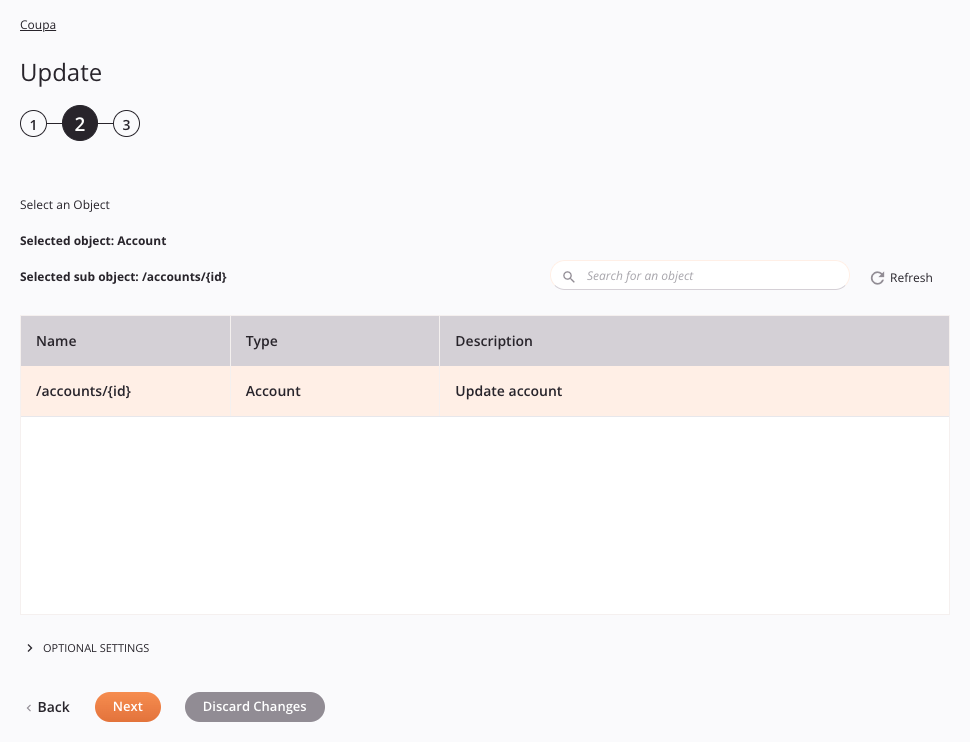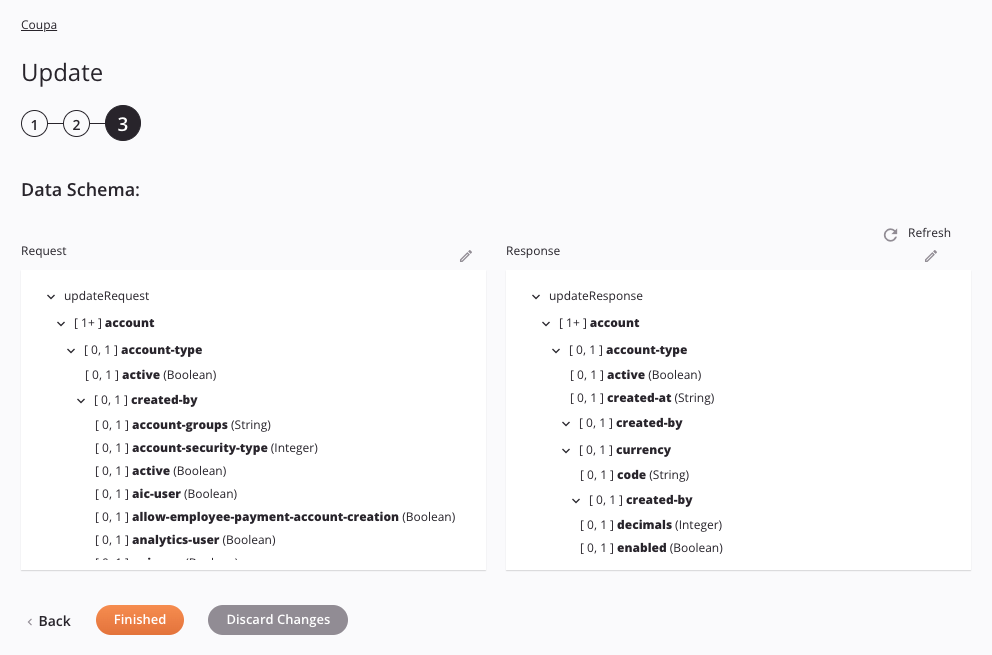Coupa Update activity
Introduction
A Coupa Update activity, using its Coupa connection, updates object data in Coupa and is intended to be used as a target to consume data in an operation.
Note
Due to a limitation present in the Coupa Core Platform API, the Coupa Update activity is unable to perform updates for the Approval and Contract objects. When using these objects in an operation, an error occurs at runtime.
Create a Coupa Update activity
An instance of a Coupa Update activity is created from a Coupa connection using its Update activity type.
To create an instance of an activity, drag the activity type to the design canvas or copy the activity type and paste it on the design canvas. For details, see Create an activity instance in Component reuse.
An existing Coupa Update activity can be edited from these locations:
- The design canvas (see Component actions menu in Design canvas).
- The project pane's Components tab (see Component actions menu in Project pane Components tab).
Configure a Coupa Update activity
Follow these steps to configure a Coupa Update activity:
-
Step 1: Enter a name and select an object
Provide a name for the activity and select an object. -
Step 2: Select a sub-object
Select a sub-object. -
Step 3: Review the data schemas
Any request or response schemas generated from the endpoint are displayed.
Step 1: Enter a name and select an object
In this step, provide a name for the activity and select an object. Each user interface element of this step is described below.

-
Name: Enter a name to identify the activity. The name must be unique for each Coupa Update activity and must not contain forward slashes
/or colons:. -
Select an Object: This section displays objects available in the Coupa endpoint.
-
Selected Object: After an object is selected, it is listed here.
-
Search: Enter any column's value into the search box to filter the list of objects. The search is not case-sensitive. If objects are already displayed within the table, the table results are filtered in real time with each keystroke. To reload objects from the endpoint when searching, enter search criteria and then refresh, as described below.
-
Refresh: Click the refresh icon
 or the word Refresh to reload objects from the Coupa endpoint. This may be useful if objects have been added to Coupa. This action refreshes all metadata used to build the table of objects displayed in the configuration.
or the word Refresh to reload objects from the Coupa endpoint. This may be useful if objects have been added to Coupa. This action refreshes all metadata used to build the table of objects displayed in the configuration. -
Selecting an Object: Within the table, click anywhere on a row to select an object. Only one object can be selected. The information available for each object is fetched from the Coupa endpoint:
-
Name: The name of the object from Coupa.
-
Description: The description of the object from Coupa.
-
Tip
If the table does not populate with available objects, the Coupa connection may not be successful. Ensure you are connected by reopening the connection and retesting the credentials.
-
-
Continue on Error: Select to continue the activity execution if an error is encountered for a dataset in a batch request. If any errors are encountered, they are written to the operation log.
-
Save & Exit: If enabled, click to save the configuration for this step and close the activity configuration.
-
Next: Click to temporarily store the configuration for this step and continue to the next step. The configuration will not be saved until you click the Finished button on the last step.
-
Discard Changes: After making changes, click to close the configuration without saving changes made to any step. A message asks you to confirm that you want to discard changes.
Step 2: Select a sub-object
In this step, select a sub-object. Each user interface element of this step is described below.

-
Select an Object: This section displays sub-objects available in the Coupa endpoint.
-
Selected Object: The object selected in the previous step is listed here.
-
Selected Sub-object: After a sub-object is selected, it is listed here.
-
Search: Enter any column's value into the search box to filter the list of sub-objects. The search is not case-sensitive. If sub-objects are already displayed within the table, the table results are filtered in real time with each keystroke. To reload sub-objects from the endpoint when searching, enter search criteria and then refresh, as described below.
-
Refresh: Click the refresh icon
 or the word Refresh to reload sub-objects from the Coupa endpoint. This may be useful if objects have been added to Coupa. This action refreshes all metadata used to build the table of sub-objects displayed in the configuration.
or the word Refresh to reload sub-objects from the Coupa endpoint. This may be useful if objects have been added to Coupa. This action refreshes all metadata used to build the table of sub-objects displayed in the configuration. -
Selecting a Sub-object: Within the table, click anywhere on a row to select a sub-object. Only one sub-object can be selected. The information available for each sub-object is fetched from the Coupa endpoint:
-
Name: The name of the sub-object from Coupa.
-
Type: The type of the sub-object from Coupa.
-
Description: The description of the sub-object from Coupa.
-
-
-
Optional Settings: Click to expand additional optional settings:
-
Enable Read Only Fields: Select to expose read-only fields from Coupa. Enabling this option will result in very large data schemas.
-
Show All Fields: Select to generate the
created-byandupdated-bynodes in the request schema. By default, these nodes are not generated. Enabling this option will result in very large data schemas.
-
-
Back: Click to temporarily store the configuration for this step and return to the previous step.
-
Next: Click to temporarily store the configuration for this step and continue to the next step. The configuration will not be saved until you click the Finished button on the last step.
-
Discard Changes: After making changes, click to close the configuration without saving changes made to any step. A message asks you to confirm that you want to discard changes.
Step 3: Review the data schemas
Any request or response schemas generated from the endpoint are displayed. Each user interface element of this step is described below.

-
Data Schemas: These data schemas are inherited by adjacent transformations and are displayed again during transformation mapping.
The Coupa connector uses the Coupa R40 Core Platform API. Refer to the API documentation for information on the schema nodes and fields.
Note
Due to a limitation present in the Coupa Core Platform API, the Coupa Update activity is unable to perform updates for the Approval and Contract objects. When using these objects in an operation, an error occurs at runtime.
-
Edit: Click the edit icon
 above each data schema to enter the edit mode for that data schema. The editor allows you to add, delete, and reorganize nodes and fields and change their data types. All occurrences of nodes and fields is set as
above each data schema to enter the edit mode for that data schema. The editor allows you to add, delete, and reorganize nodes and fields and change their data types. All occurrences of nodes and fields is set as [0, 1]cardinality. Changes made to the data schemas must be acceptable to the endpoint and should be made only after consulting any available documentation for the endpoint. -
Refresh: Click the refresh icon
 or the word Refresh to regenerate schemas from the Coupa endpoint. This action also regenerates a schema in other locations throughout the project where the same schema is referenced, such as in an adjacent transformation.
or the word Refresh to regenerate schemas from the Coupa endpoint. This action also regenerates a schema in other locations throughout the project where the same schema is referenced, such as in an adjacent transformation. -
Back: Click to temporarily store the configuration for this step and return to the previous step.
-
Finished: Click to save the configuration for all steps and close the activity configuration.
-
Discard Changes: After making changes, click to close the configuration without saving changes made to any step. A message asks you to confirm that you want to discard changes.
Next steps
After configuring a Coupa Update activity, complete the configuration of the operation by adding and configuring other activities, transformations, or scripts as operation steps. You can also configure the operation settings, which include the ability to chain operations together that are in the same or different workflows.
Menu actions for an activity are accessible from the project pane and the design canvas. For details, see Activity actions menu in Connector basics.
Coupa Update activities can be used as a target with these operation patterns:
- Transformation pattern
- Two-transformation pattern (as the first or second target)
To use the activity with scripting functions, write the data to a temporary location and then use that temporary location in the scripting function.
When ready, deploy and run the operation and validate behavior by checking the operation logs.